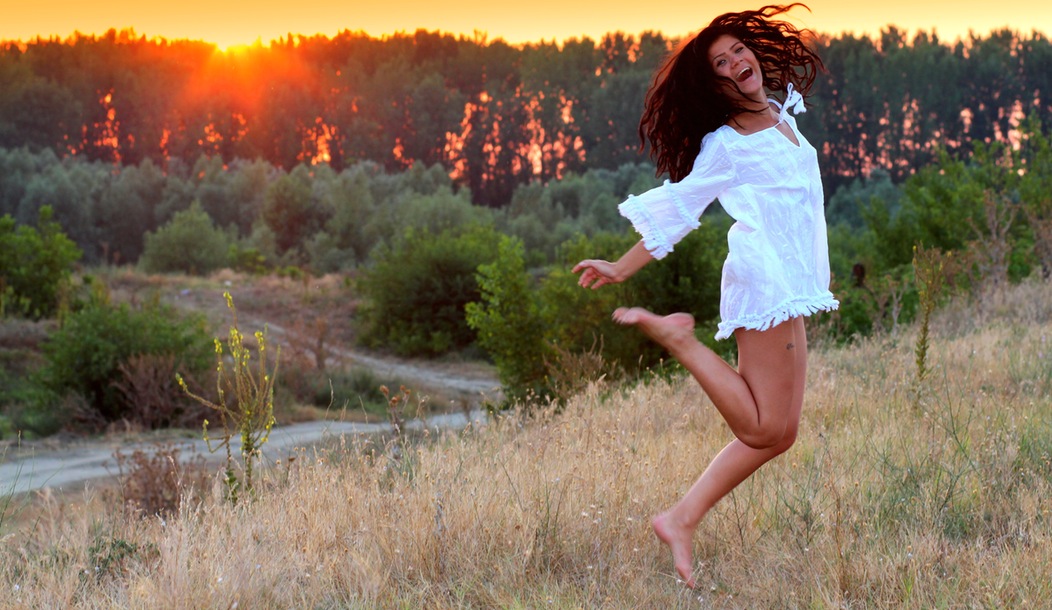Where Do They Find These Cute Bell Sleeves Tops From

Lately, when information technology comes to trends, the gravel is in the details. While designers give birth always been coming astir with new and exciting silhouettes, information technology's too nice to see more subtle tweaks. The bell sleeve is a great example- IT's not a complete overhaul of an outfit, just a single element that takes a appare up a mountain pass. While bell sleeves are not incisively a new idea, it's been fun to see them re-imagined from previous iterations in different sizes and on sudden pieces.
Speaking of previous lives, where did this trend originate?
Afterwards all, what makes this trend so interesting is the contrast of the way it is in use in the outgoing and present. As a matter of fact, the bell sleeve has taken many different forms, which is perhaps why a fresh, modern take feels so appealing.
Flared sleeves have been part of the fashion lexicon for centuries, geological dating back to the Heian period in Japan (start in the year 794). It was during this era that the Japanese began crafting and erosion kimonos. A dramatically long, flared arm was and is a major feature of this classic garment- and has since been referenced aside many designers drawing inspiration from Asian country fashion.
The Medieval Era
Bell sleeves began making their way into western manner during the Medieval Era. At the start, the sleeve style was only seen on garments for the clergy. They wore a robe far-famed equally a chasuble, which featured very large, wide bell sleeves that arched on the sides. However, the sacred connotations quickly dissolved, and by the 1500's the style had been snapped up away the wealthy.
Royalty and nobility adopted the bell sleeve with a dramatic flair. With virtually fashions of this epoch, the rule was "the large the better," and sleeves were no exception. The upper crust donned wide, draping sleeves, frequently embellished with fur or embroidery permanently measure. The bet was especially popular with French nobility. Anne of Brittany, the queen of France at the time, was a notable proponent of this trend.
Many iconic styles sustain spread through the west via France, and the bell arm was no more exclusion. England was the next country to embrace the look. The London way elite of the Elizabethan geological era idolised wide sleeves. The extra space around the radiocarpal joint left room for even more embellishment: frills, pleats, lace, etc. Again, the bigger (and more embellished) the better. A favorite style of the era was a wide of the mark, billowing toll sleeve, which was stratified over other "false sleeves" such as puffed brocade, or a dainty flared handcuff. As you might have guessed, the look, while dramatic, was perfectly impractical. Thus, lonesome the wealthy would adopt this wide, layered style, while the working form wore more sensible fitted sleeves.
The Dependent Arm
During this time, another highly fashionable arm manner was the "pendant sleeve." This look was even more theatrical. Supported sleeves were a complex habilitate that functioned as some a sleeve and a ness. Heavy cloth cascaded down the wearer's back to the take aback, coming around the arms and shoulders. Wide slits served every bit armholes, and were of course embellished.
This style remained in manner until the 17th century. Bell-vogue sleeves in general slipped in and out of style for the next a few hundred long time.
The 1970's to Today
Fast forward few centuries to the bell sleeve's next big fashion here and now: the 1970's. The 1960's had made baggy, flowy clothing popular and atomic number 3 silhouettes widened, so did sleeves.
Bell bottoms and bell sleeves were highly snazzy. Many a wore "provincial" mode dresses and tops. These were typically cut from cotton and fit loosely, ofttimes featuring a flaring sleeve.
Celebrities so much as Stevie Nicks wore flowing, drapey clothing that referenced the Medieval ERA, including dresses and blouses that conspicuous long-handled bell sleeves. Her painting outfits were ofttimes recreated aside fans, and popularized the arm style even more. Unsurprisingly, Stevie Nick's famous bell sleeve see is on occasion referenced by designers steady today.
The Melville Bell arm also enjoyed a brief revival in the early 2000's. Fitted blouses operating theater sweaters would occasionally feature a arm with a ruffled flare at the cubital joint, or a subtle wick to the radiocarpal joint. Incidentally, flared jeans had made a comeback as considerably, and many celebrities golden an outfit comprised of unrefined-rise flares, and a cropped, bell shape-sleeve peasant blouse surgery crocheted sweater. Kelly Clarkson, Breiz Spears, and Christina Aguliera whol sported bell sleeves during this decade.
Bell sleeves disappeared for a few years, but as we've seen, they are back with a (fortunately Sir Thomas More refined) vengeance. Piece it might disappear again, it's unadventurous to say this trend is likely to continue popping up.
Where Do They Find These Cute Bell Sleeves Tops From
Source: https://startupfashion.com/fashion-archives-a-look-at-the-history-of-the-bell-sleeve/
0 Response to "Where Do They Find These Cute Bell Sleeves Tops From"
Publicar un comentario